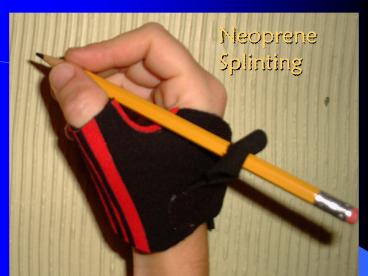Neoprene Splinting - PowerPoint PPT Presentation
1 / 17
Title:
Neoprene Splinting
Description:
thicker materials have more resistance to stretch ... abut edges together, use Velcro to secure. seam curves first. lay tape over abutted edges. use iron on ... – PowerPoint PPT presentation
Number of Views:664
Avg rating:3.0/5.0
Title: Neoprene Splinting
1
Neoprene Splinting
2
Characteristics
- Elasticity
- pull is in all directions
- loses 10-15 over time
- thicker materials have more resistance to stretch
and poor conformability - added fabrics can decrease elasticity
3
- Insulation
- Composed of closed cells making a barrier to
external environment - Applications
- acute injuries for compression/edema
- cold intolerance e.g.. Raynauds, crush, or
amputation - arthritis comforted by warmth
- support of muscles needing warmth/compression
- those working in cold water/temperatures
- Caution against maceration due to non- absorption
of perspiration
4
- Cushioning
- May be used with hard splints
- Decreases shearing forces by absorbing external
force - note increased shear when donning if sliding over
skin - Does not permanently compress when put under a
load over time - good for padding - Do not place directly over bony prominence but
around it.
5
Applications
- Can be used where many thermoplastic splints are
indicated - reinforce if needed - Can be effective for assisting in stabilization
of joints caused by weak muscles or fluctuating
tone - Can provide similar results such as joint
compression and tapping achieved through NDT and
SI techniques - Can assist in bringing spastic joints to neutral
6
Thickness of Material
- 1/16 Finger Splints
- 1/8 Wrist Elbow
- 1/2 Trunk or Large Joints
- You can buy Neoprene with various types of
backing added to one or two sides - Nylon knits add little thickness
- Teri backing adds more
- Loop adds maximum
7
Pros and Cons
- Aesthetic appearance
- Comfort by warmth and softness
- Conformability
- Ease of material setup
- Ease of fabrication
- IT IS HOT to wear
- Maceration can occur
- Protocols, patterns, and efficacy not yet
established
8
Pattern Making
- Make a foil pattern first
- Cut larger than usual if using a less elastic
material - Make inside curves 5-10 smaller
- Make outside curves 10 larger than usual
- Use disappearing pen or chalk
- Cut with scissors or rotary blade
9
Fitting
- Glue seams with bonding cement
- outer fabrics such as teri, loop or nylon do not
adhere - rubber neoprene core adheres
- wait a few minutes after applying before
contacting both sides - Use dowel or tubes for curved seams
- Can be undone by pulling or cutting
- Once fit is confirmed on patient, use seam tape
10
Seam Tape
- Use seam tape to reinforce and make bond
permanent - Cannot be removed once cooled
- Reinforces bond
11
Seam tape cont.
- abut edges together, use Velcro to secure
- seam curves first
- lay tape over abutted edges
- use iron on medium heat, no steam
- hold, DO NOT SLIDE iron for 30 sec
- increase temp if not bonded after 60 sec
- let tape cool 24 hours before stressing
- with curves, multiple short strips can be used
12
Fasteners and Straps
- Neoprene lined with loop only needs hook
fasteners - Iron on or solvent activated hook and loop will
adhere to nylon or Teri lined neoprene - Can be sewn into place
13
Fasteners and Straps
- Neoprene can be used for straps on splints
- How to secure to splint
- Velcro
- rivets must have metal or plastic washer
- non coated material doubled on top
14
REINFORCEMENT
- A pocket reinforcement can be added to hold
thermoplastic or metal reinforcement - Pocket should be made and added before final
fitting on circumferential splints
15
REINFORCEMENT
- Another option is to use non-coated (sticks to
itself) thermoplastic splinting material that
will adhere to loop or nylon fabric outside of
neoprene splint - Thermoplastic material can be attached under
neoprene splint with Velcro
16
Care
- Wash by hand with cold water
- Can be machine washed on gentle with cold water
- Velcro closures must be closed
- never put it in the dryer
17
Other Ideas for Neoprene Applications

